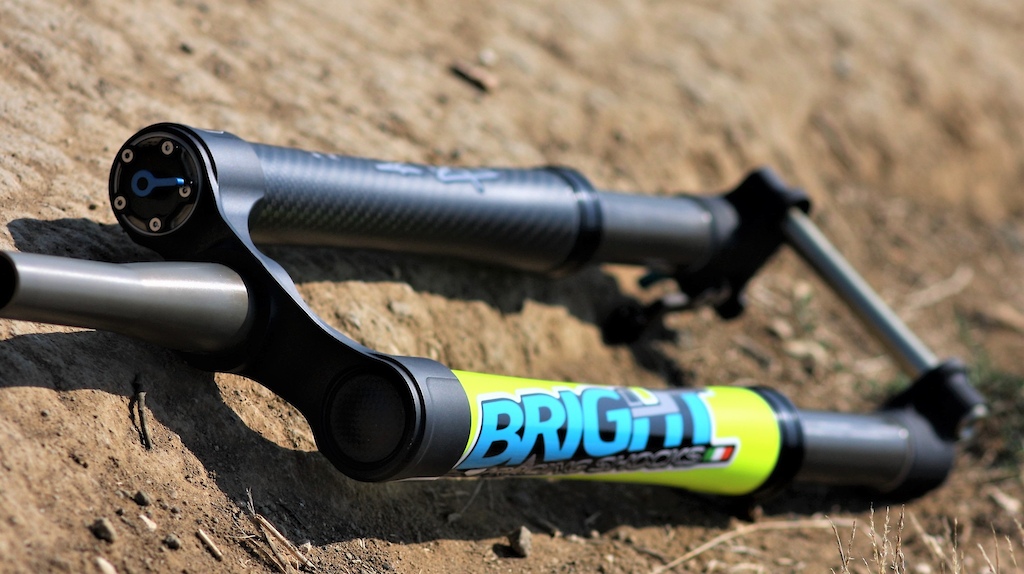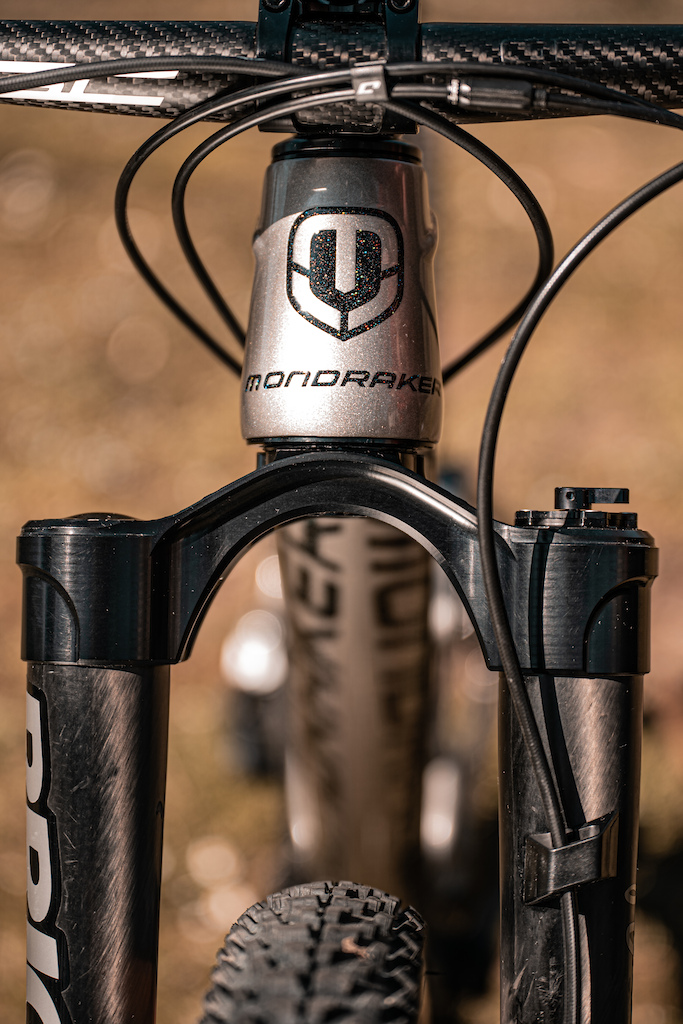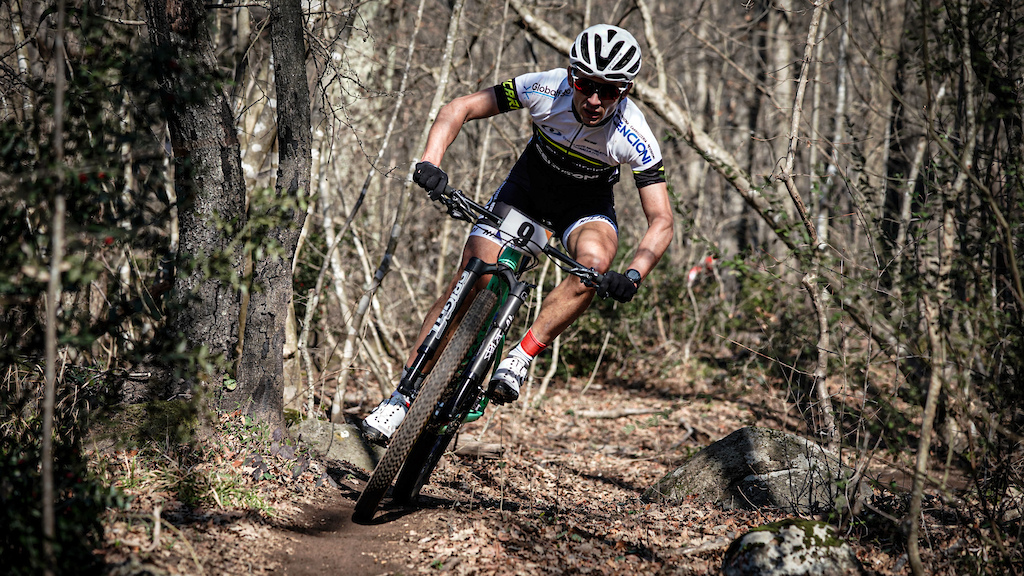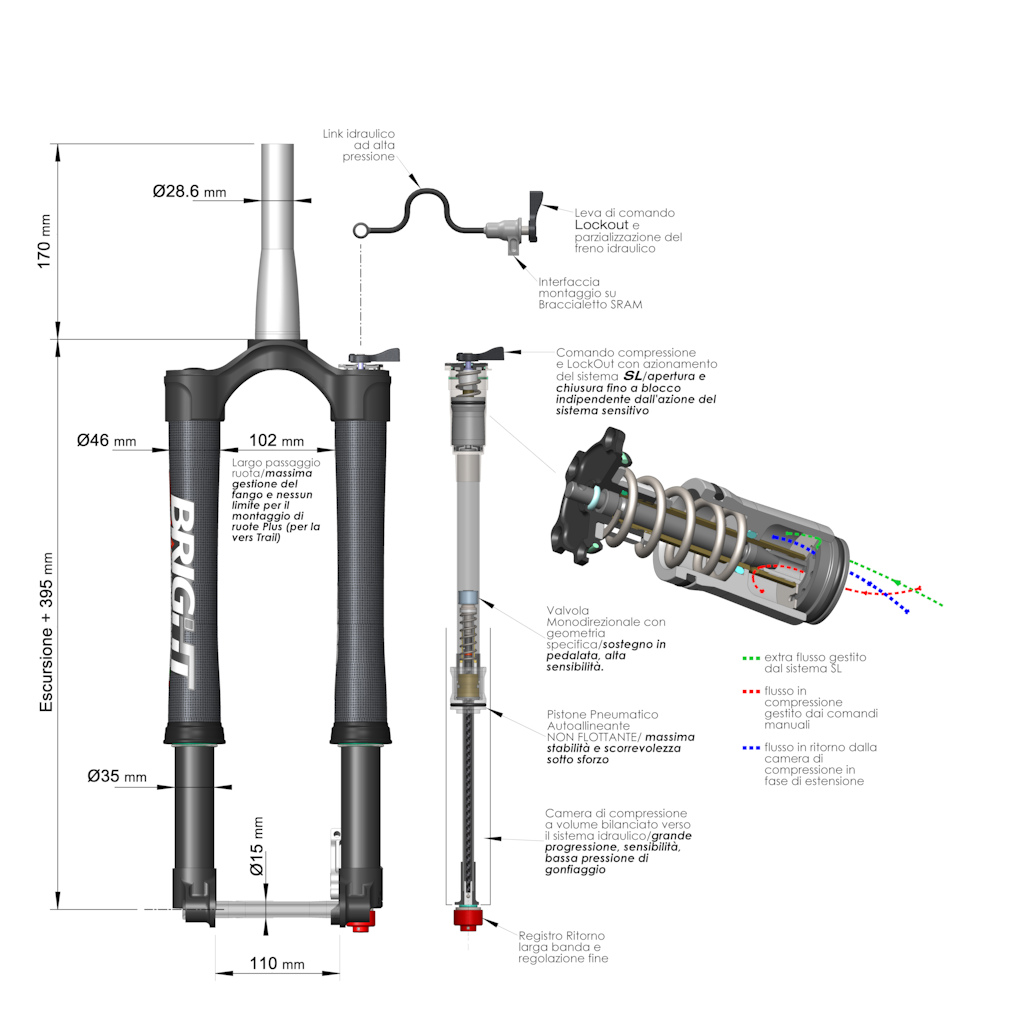Bright Racing Shocks' 1630g Inverted Fork Claims 'Better Precision Than a Traditional Fork' - Pond Beaver 2021
Recently, The European Bike Project directed our attention to the hand-made inverted forks from Italian micro-brand, Bright Racing Shocks. In particular, their 100-120mm travel XC/Marathon fork, the F929 xCO. It looks like a work of art and has a claimed weight of just 1,630 grams. For context, the RockShox RS-1 weighs 1,666 grams.
On the other hand, the (right-way-up) RockShox SID weighs 1,537 grams, or 1,326-grams for the 100mm-travel SID SL. That is, you know, less. However, Bright's founder and designer, Pablo Fiorilli, claims their fork offers "better precision and rigidity than a top traditional fork." Big words.
On the other hand, the (right-way-up) RockShox SID weighs 1,537 grams, or 1,326-grams for the 100mm-travel SID SL. That is, you know, less. However, Bright's founder and designer, Pablo Fiorilli, claims their fork offers "better precision and rigidity than a top traditional fork." Big words.
Bright Racing Shocks F929 xCO Details
• Intended use: Cross-country / trail
• Travel: 100-120mm
• Wheel size: 29" only
• Stanchions: 35mm
• Upper legs: 46mm diameter carbon-fiber
• Crown: CNC Aluminium
• Weight: 1,630-grams (claimed)
• MSRP: 1,780 Euros
• Bright Racing Shocks
• Intended use: Cross-country / trail
• Travel: 100-120mm
• Wheel size: 29" only
• Stanchions: 35mm
• Upper legs: 46mm diameter carbon-fiber
• Crown: CNC Aluminium
• Weight: 1,630-grams (claimed)
• MSRP: 1,780 Euros
• Bright Racing Shocks
Upside-down (USD) forks have a patchy history within mountain biking. The Marzocchi Shiver, Manitou Dorado and RockShox RS-1 all had die-hard fans but didn't exactly see mainstream adoption. The appeal of USD forks is that the wiper seal and bushings sit at the bottom of the fork, meaning they stay well-lubricated in bath oil, and the stanchions and wiper seal aren't in the direct firing-line of debris from the tire. The larger-diameter upper tubes generally result in superior fore-aft stiffness too, although the lack of an arch tying the legs together above the tire makes them typically flexier when it comes to lateral or torsional (twisting) forces. This usually results in either unpredictable steering or a significant weight penalty to try and engineer-out the flex.
Pablo says they achieved this competitive lightness and stiffness thanks to 46mm-diameter carbon-fiber upper tubes and broad (for cross country) 35mm stanchions, plus a crown machined from high-strength 7075-T651 aluminium. The thru-axle is the familiar 15x110mm standard (no over-sized thru-axle intended to add stiffness), but there is the option to use SRAM's Torque Cap hub interface for extra steering precision.
The crown is said to weigh just 310g and is machined down from a 2.7Kg billet. Presumably, the other 88.5% of the material is recycled. Other details include a replaceable 160mm brake mount, 35mm lower legs (stanchions), a highly-progressive air spring and what Bright calls their Sensitive Lockout damping, which apparently does away with the need for a remote lockout as it minimizes bob thanks to a three-way compression valve.
But the boutique rarity of the brand is perhaps its biggest appeal. "Think about a hand-made frame builder but for suspension," Pablo explains. "Our business is to make something where you can find real hand made care together with high performance. We deliver a fork tuned expressly for the customer, assembled for him in 2 months."
You'll have to really want to stand out to pay the 1,780-Euro asking price, however. And as always, I'd view the stiffness and performance claims with a grain of salt. After all, the inverted mountain bike fork is a graveyard for promising claims that never quite worked out. Nevertheless it's great to see small manufacturers finding new and innovative ways to get around the same problems. The exclusivity which comes with such a niche brand is appealing and we'd love to get our hands on one in future.
Author Info:
Must Read This Week
Sign Up for the Pinkbike Newsletter - All the Biggest, Most Interesting Stories in your Inbox
PB Newsletter Signup









................couldn’t stand them !
I can assure you that all the hours of technology and development within this brand have real value and you feel them when you drive.
this topic is real and sacred to me.
and you asked a correct question.
but I am used to approaching arguments in a pragmatic way.
then I answer ....:
in Europe we have an organized service with people personally trained by me and continuously active on competitions and tests.
These service centers, as well as the parent company, guarantee service via express courier in one or two weeks (depending on various factors).
We are in the US
looking for a service center that is also a distributor.
the nature of Bright and of our work is that of a racing department.
WE DO INNOVATION ... yes but we don't do it to go for a walk. we are pragmatic and
aimed at racing use.
The F929 was designed (by me,
so i know what i say) like a real race suspension. Contrary to low-cost forks (sold at high figures but
low cost production .....) Bright does not need gurus or sorcerers to return to perfect condition.
high-level projects are like that.
Completely disassembling the F929 frame requires a small flat screwdriver, a 1.5mm Allen wrench, an 18mm hex wrench and 5 minutes of work.
Your good explanations and our support from the parent company are always available.
This is our nature.
I personally design and develop racing suspensions and avionics systems from
30 years. My job is to carry out sustainable and innovative projects. You don't plan to count the customer.
Just think that every single gasket is available as a standard all over the world.
cartridge orings are standard fit.
the dust scrapers
exteriors are standard Rock Shox 35 mm.
not only....
Bright Racing Shocks forks have the gasket pack mounted in a special
floating capsule that also allows you to change the standard of external seals ...
Forks sold out
europa can be supplied with two service kits (two years) at a special price.
the cartridge can arrive from Italy with custom tuning in two weeks.
Yet???? We can talk for days. I hope I have answered at least partially
32" makes perfect sense for XXL bikes as this pic proves: www.instagram.com/p/CNZQTPtnSgp
Cheers!
You do realize this is an industry where there are showroom stock builds for $10-12,000? Where the $3-4,000 difference to the next lower model is literally just for a few hundred grams, often with zero functional improvements?
You and @justinfoil are aggressively agreeing with Seb, as the people who spend 12k on a specialized are... Wait for it... people who want to stand out.
Try an Unno, Zerode or other small boutique brand for that matter
It is a clutched, wide range 9spd by box.
Spending "too much" isn't always about "standing out". Sometimes it's about trying new things, supporting ideas you think could be good, and supporting the folks trying to realize those ideas.
You're right that a professional racer who might literally put food on their table based on results probably isn't going to spend hard earned race winnings and sponsor salary on something that is unproven and has no immediate outward performance benefits. But most of us aren't professional racers: we just want to ride rad places and do fun shit on our sick bikes and maybe help some motivated people make cool parts, and some of us are more than willing do spend quite a bit on that.
And this is coming from someone who is definitely not the target audience for this fork (even my hardtail's fork has more travel and is heavier); I just think it's bad form to pre-judge anyone paying that price as just wanting to "stand out".
Road racers (moto) swap out inverted forks to improve COG and hence corner speed
haven't tried much new stuff but the 27,5 dorado i have is a dissapointment in this regard
The bushings are higher in the fork, since the stanchions slide up, creating more toque upon impact.
If the usd world didn't keep making these grandiose claims, maybe they'd have a better shot at the market haha!
Good boy! these are two and three fundamental points.
Remember that Bright is first of all a developer and we have been designing suspension especially for mtb for 32 years.
our guides have always been mobile (see Fimoco Engineering in the 90s) as in mx.
we are the only manufacturers to obtain the shafts from solid billett and grind with cylindricity and ovalization below 5 microns.
the guides are rolled to tight tolerances.
These technological features come from my experience (16 years) in the aerospace sector; not only in racing suspension job, and they are unthinkable in mtb suspension brands today.
then there are other factors that determine the performance of the F929 and all since
mechanical design.
Testing on the bike is the final word.
thanks a lot.
The differences are a direct and deep control of all aspects.
And increase every weeks in something
@hamncheez The way I see it, I think if we treat the whole bike as a frame, two supports will be axles. While supporting force applies on contact patches and rider at the BB and a bit at the bars, we can assume for the sake of this exercise (at least in fore aft aspect) that we treat axles as supports. The further from support you get the more bending momentum is applied to the part we are looking at. This gets even worse for STD fork if we take into account tire contact patches and side loads, as well as twisting loads, the USD fork wins. There will be more deflection higher up the fork than lower in the fork in both cases though, especially thinking about the axle as rotating, not fixed support. If we look closer and the crown race is the upper support while axle is the lower support of the "rod" the most of deflection will happen in the middle. Some actual engineer can correct me...
The way I see it - glide bushing is superior in either case since bushing spacing matters most here. With glide bushing the outer part of the telescopic solution stiffens up the whole system where STD fork always relies on default bushing spacing and force is always applied to lower via bushings, so lowers don't play much of a role in stiffening the whole thing. Only length decrease due to fork compression, decreases deflection.
-DVO, Halson, Magura, Manitou, Maverick, Rock Shox, X-Fusion, others
Non-boutique companies that currently sell USD forks:
Cannondale, RST
And Cannondale succeeded because they went nuclear on stiffness with three tricks no one else has tried- integrated leg-axle assembly, square legs, two crowns.
the transverse forces do not necessarily pass through the wheel axis.
the guides and then the analysis of the loads are the way.
www.bikeradar.com/reviews/components/forks/suspension-forks/rockshox-rs-1-review
RS1 is one thing, BRIGHT F929 is a totally different thing.
In design, solutions and technologies...
Totally different.
In my opinion (from an engineering point of view) the sram hub is a real
Masterpiece. But our guide and legs solutions are far-from a low cost mtb commercial fork
...enter downvotes from stupid dentist offsprings
You do have an Italian lakeside vineyard, don't you?